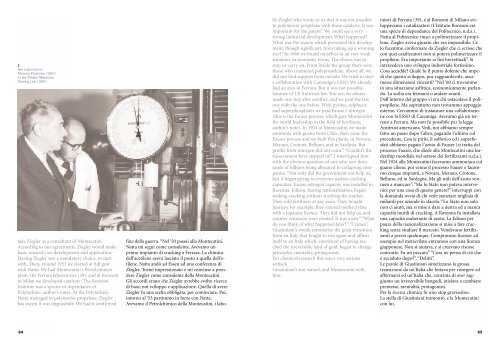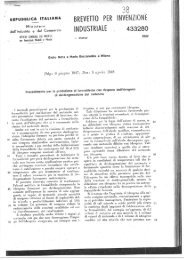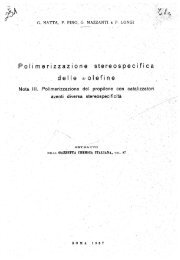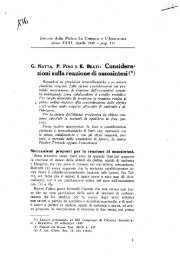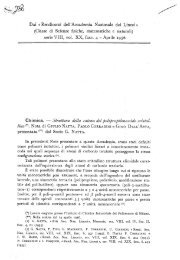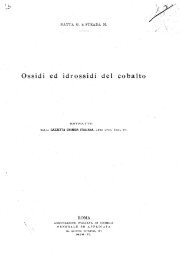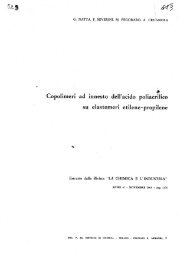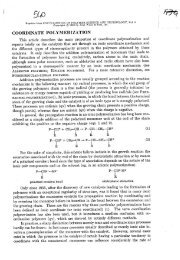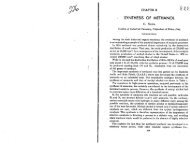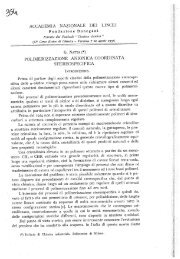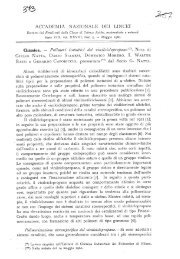n. 7, Ottobre 2003 - Giulio Natta
n. 7, Ottobre 2003 - Giulio Natta
n. 7, Ottobre 2003 - Giulio Natta
Create successful ePaper yourself
Turn your PDF publications into a flip-book with our unique Google optimized e-Paper software.
2.<br />
Nel Laboratorio<br />
Materie Plastiche (1957)<br />
In the Plastic Materials<br />
Testing Lab (1957)<br />
fine della guerra. “Nel ‘50 passai alla Montecatini.<br />
<strong>Natta</strong> mi seguì come consulente. Avevamo un<br />
primo impianto di cracking a Ferrara. La chimica<br />
dell'acetilene aveva lasciato il posto a quella dell'etilene.<br />
<strong>Natta</strong> andò ad Essen ad una conferenza di<br />
Ziegler. Tornò impressionato e mi convinse a prendere<br />
Ziegler come consulente della Montecatini.<br />
Gli accordi erano che Ziegler avrebbe svolto ricerca<br />
di base, noi sviluppo e applicazione. Quella di avere<br />
Ziegler fu una scelta obbligata, per cominciare. Poi,<br />
intorno al ‘53 partimmo in forze con <strong>Natta</strong>.<br />
Avevamo il Petrolchimico della Montecatini, i labotake<br />
Ziegler as a consultant of Montecatini.<br />
According to our agreements, Ziegler would make<br />
basic research, we development and application.<br />
Having Ziegler was a mandatory choice, to start<br />
with. Then, around 1953 we started at full gear<br />
with <strong>Natta</strong>. We had Montecatini’s Petrolchimico<br />
plant, the Ferrara laboratories (39), and at Ronzoni<br />
in Milan we developed catalysts (The Ronzoni<br />
Institute was a species of dependance of<br />
Polytechnic; author’s note). At the Polytechnic<br />
<strong>Natta</strong> managed to polymerise propylene. Ziegler<br />
has sworn it was impossibile. We had it confirmed<br />
by Ziegler who wrote to us that it was not possible<br />
to polymerise propylene with those catalysts. It was<br />
important for the patent”. We could see a very<br />
strong industrial development. What happened?<br />
What was the reason which prevented this development,<br />
though significant, from taking up a winning<br />
size? “In 1960 we found ourselves in an very weak<br />
situation, in economic terms. The choice was to<br />
stop or carry on. From inside the group there were<br />
those who countered polypropylene. Above all, we<br />
did not find support from outside. We tried to start<br />
a collaboration with Cazzaniga’s ESSO. We already<br />
had an area in Ferrara. But it was not possible<br />
because of US Antitrust law. You see, we always<br />
made one step after another, and we paid the last<br />
one with the one before. With pyrites, sulphuric<br />
and superphosphates we paid Fauser’s nitrogen<br />
(this is the Fauser process, which gave Montecatini<br />
the world leadership in the field of fertilisers,<br />
author’s note). In 1924 at Montecatini we made<br />
ammonia with guano from Chile, then came the<br />
Fauser process and we built five plants, in Novara,<br />
Merano, Crotone, Belluno, and in Sardinia. But<br />
profits from nitrogen did not come”. “Couldn’t the<br />
Government have stepped in?” I interrupted him<br />
with the obvious question of one who sees thousands<br />
of billions being allocated to collapsing companies.<br />
“Not only did the government not help us,<br />
but it began giving to everyone useless cracking<br />
capacities. Excess nitrogen capacity was installed in<br />
Ravenna. Edison, fearing nationalisation, began<br />
making cracking without studying the market.<br />
They sold fertilisers at any price. They bought<br />
licences: for example, they entered methacrylate<br />
with a Japanese licence. They did not help us, and<br />
counter resources were created. It was a pity” “What<br />
do you think of what happened later?”. “Crimes”.<br />
Giustiniani’s words summarise the great transition<br />
from an Italy that fought to rise again and affirm<br />
itself to an Italy which, convinced of having reached<br />
the irreversible land of gold, began to change<br />
principles, mentality, protagonists.<br />
For chemical research this was a very serious<br />
setback.<br />
Giustiniani’s star waned, and Montecatini with<br />
him.<br />
ratori di Ferrara (39), e al Ronzoni di Milano sviluppavamo<br />
i catalizzatori (L’Istituto Ronzoni era<br />
una specie di dependance del Politecnico, n.d.a.).<br />
<strong>Natta</strong> al Politecnico riuscì a polimerizzare il propilene.<br />
Ziegler aveva giurato che era impossibile. Ce<br />
lo facemmo confermare da Ziegler che ci scrisse che<br />
con quei catalizzatori non si poteva polimerizzare il<br />
propilene. Era importante ai fini brevettuali”. Si<br />
intravedeva uno sviluppo industriale fortissimo.<br />
Cosa accadde? Quale fu il punto dolente che impedì<br />
che questo sviluppo, pur ragguardevole, assumesse<br />
dimensioni vincenti? “Nel ‘60 ci trovammo<br />
in una situazione asfittica, economicamente parlando.<br />
La scelta era fermarsi o andare avanti.<br />
Dall’interno del gruppo vi era chi ostacolava il polipropilene.<br />
Ma soprattutto non trovammo appoggio<br />
esterno. Cercammo di instaurare una collaborazione<br />
con la ESSO di Cazzaniga. Avevamo già un terreno<br />
a Ferrara. Ma non fu possibile per la legge<br />
Antitrust americana. Vedi, noi abbiamo sempre<br />
fatto un passo dopo l’altro, pagando l’ultimo col<br />
precedente. Con le piriti, il solforico ed i superfosfati<br />
abbiamo pagato l’azoto di Fauser (si tratta del<br />
processo Fauser, che diede alla Montecatini una leadership<br />
mondiale nel settore dei fertilizzanti n.d.a.).<br />
Nel 1924 alla Montecatini facevamo ammoniaca col<br />
guano cileno, poi venne il processo Fauser e facemmo<br />
cinque impianti, a Novara, Merano, Crotone,<br />
Belluno, ed in Sardegna. Ma gli utili dell’azoto vennero<br />
a mancare”. “Ma lo Stato non poteva intervenire<br />
per una cosa di questo genere?” interruppi con<br />
la domanda ovvia di chi vede stanziare migliaia di<br />
miliardi per aziende in sfacelo. “Lo Stato non solo<br />
non ci aiutò, ma si mise a dare a destra ed a manca<br />
capacità inutili di cracking. A Ravenna fu installata<br />
una capacità esuberante di azoto. La Edison per<br />
paura della nazionalizzazione si mise a fare cracking<br />
senza studiare il mercato. Vendevano fertilizzanti<br />
a prezzi qualunque. Compravano licenze: ad<br />
esempio nel metacrilato entrarono con una licenza<br />
giapponese. Non si aiutava, e si creavano risorse<br />
contrarie. Fu un peccato” “Cosa ne pensa di ciò che<br />
è accaduto dopo?”, “Delitti”.<br />
Le parole di Giustiniani sintetizzano la grossa<br />
transizione da un’Italia che lottava per risorgere ed<br />
affermarsi ed un’Italia che, convinta di aver raggiunto<br />
un irreversibile bengodi, iniziava a cambiare<br />
premesse, mentalità, protagonisti.<br />
Per la ricerca chimica fu uno stop gravissimo.<br />
La stella di Giustiniani tramontò, e la Montecatini<br />
con lui.<br />
64<br />
65


